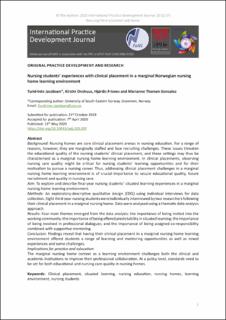| dc.contributor.author | Jacobsen, Turid Iren | |
| dc.contributor.author | Onshuus, Kirstin | |
| dc.contributor.author | Frisnes, Hjørdis | |
| dc.contributor.author | Gonzalez, Marianne Thorsen | |
| dc.date.accessioned | 2020-05-22T07:32:02Z | |
| dc.date.available | 2020-05-22T07:32:02Z | |
| dc.date.created | 2020-05-13T13:09:36Z | |
| dc.date.issued | 2020 | |
| dc.identifier.citation | International Practice Development Journal. 2020, 10 (1), 1-14. | en_US |
| dc.identifier.issn | 2046-9292 | |
| dc.identifier.uri | https://hdl.handle.net/11250/2655260 | |
| dc.description.abstract | Background: Nursing homes are core clinical placement arenas in nursing education. For a range of reasons, however, they are marginally staffed and face recruiting challenges. These issues threaten the educational quality of the nursing students’ clinical placement, and these settings may thus be characterised as a marginal nursing home learning environment. In clinical placements, observing nursing care quality might be critical for nursing students’ learning opportunities and for their motivation to pursue a nursing career. Thus, addressing clinical placement challenges in a marginal nursing home learning environment is of crucial importance to secure educational quality, future recruitment and quality in nursing care.
Aim: To explore and describe final-year nursing students’ situated learning experiences in a marginal nursing home learning environment.
Methods: An exploratory-descriptive qualitative design (EDQ) using individual interviews for data collection. Eight third-year nursing students were individually interviewed by two researchers following their clinical placement in a marginal nursing home. Data were analysed using a thematic data analysis approach.
Results: Four main themes emerged from the data analysis: the importance of being invited into the working community; the importance of being offered predictability in situated learning; the importance of being involved in professional dialogues; and the importance of being assigned co-responsibility combined with supportive mentoring.
Conclusion: Findings reveal that having their clinical placement in a marginal nursing home learning environment offered students a range of learning and mentoring opportunities as well as mixed experiences and some challenges.
Implications for practice and education:
The marginal nursing home context as a learning environment challenges both the clinical and academic institutions to improve their professional collaboration. At a policy level, standards need to be set for both educational and nursing care quality in nursing homes. | en_US |
| dc.language.iso | eng | en_US |
| dc.publisher | Foundation of Nursing Studies (FONS) | en_US |
| dc.relation.uri | https://www.fons.org/library/journal/volume10-issue1/article7 | |
| dc.rights | Navngivelse-Ikkekommersiell 4.0 Internasjonal | * |
| dc.rights.uri | http://creativecommons.org/licenses/by-nc/4.0/deed.no | * |
| dc.title | Nursing students’ experiences with clinical placement in a marginal Norwegian nursing home learning environment | en_US |
| dc.type | Peer reviewed | en_US |
| dc.type | Journal article | en_US |
| dc.description.version | publishedVersion | en_US |
| dc.source.pagenumber | 1-14 | en_US |
| dc.source.volume | 10 | en_US |
| dc.source.journal | International Practice Development Journal | en_US |
| dc.source.issue | 1 | en_US |
| dc.identifier.doi | 10.19043/ipdj.101.007 | |
| dc.identifier.cristin | 1810780 | |
| dc.description.localcode | This article by Turid-Irén Jacobsen, Kirstin Onshuus, Hjørdis Frisnes and Marianne Thorsen Gonzalez is licensed under a Creative Commons Attribution Non-Commercial 3.0 License. | en_US |
| cristin.ispublished | true | |
| cristin.fulltext | original | |
| cristin.qualitycode | 1 | |

